South Dakota is home to an abundance of natural beauty, wildlife, and all kinds of outdoor adventures. However, there are also many natural dangers here as well, like coyotes, bears, and mountain lions—but what about snakes? Remarkably, only one of the 15 or more snake species living in South Dakota is venomous and dangerous to humans. Let’s take a closer look at South Dakota’s one and only rattlesnake species: the prairie rattlesnake.
Prairie Rattlesnake
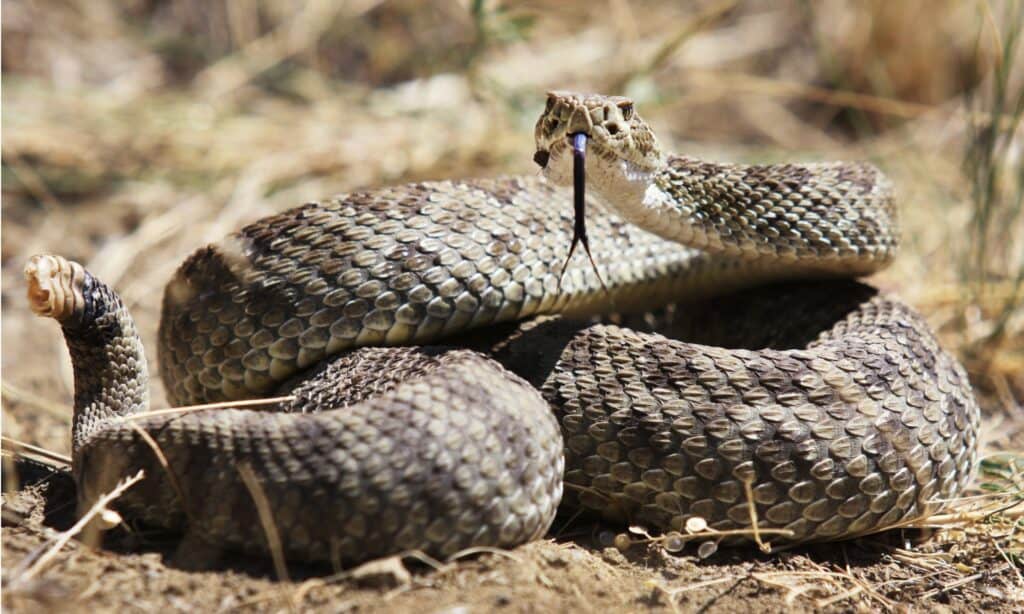
Keeled or ridged scales give prairie rattlesnakes a rough and bristly appearance.
©iStock.com/HRossD
| Prairie Rattlesnake | |
|---|---|
| Range | The western half of South Dakota |
| Length | 24-48 inches |
Prairie rattlesnakes are the only dangerous snakes in South Dakota, most commonly found in the western half of the state. These snakes prefer grassland areas, prairies, rocky outcroppings, spruce forests, and prairie dog towns. They primarily eat rodents but will also eat lizards and birds if available. As pit vipers, prairie rattlesnakes use the pit sensors on their faces to detect heat radiating from their prey. They are ambush predators, quietly lying in wait until their prey walks by and attacking with deadly speed.
As the only rattlesnake species in the state, prairie rattlesnakes in South Dakota are easily identified by the keratin rattle at the end of their tails. However, baby rattlesnakes—or even older rattlesnakes whose rattles have been broken—might have a “button” or the beginnings of a rattle without any additional segments. Each time the snake sheds, another segment is added to its rattle, allowing the rattlesnake to vibrate its tail and make the iconic “rattling” sound.
What Does a Prairie Rattlesnake Look Like?
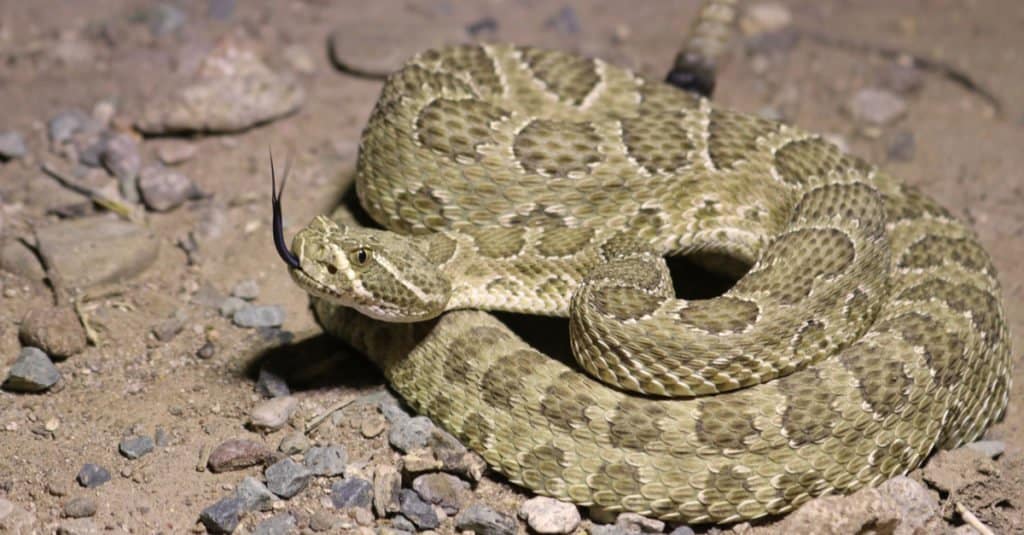
Prairie rattlesnakes have heavy bodies covered in keeled scales that give them a very rough texture.
©Creeping Things/Shutterstock.com
The largest prairie rattlesnake on record was an astounding 6 feet in length. However, the prairie rattlesnakes in South Dakota are much smaller, measuring around 2-4 feet long instead.
Prairie rattlesnakes have tan or light gray bodies that help them blend into prairie and grassland environments. They are marked with dark blotches along the length of their bodies, outlined by a lighter cream or white color. Smaller dark blotches also adorn their sides. They have dark bands instead of blotches near the end of their tails. These snakes have heavy-looking bodies covered in keeled scales that give them a very rough texture.
Other Snakes in South Dakota
While the prairie rattlesnake is the only venomous snake in South Dakota, there are many nonvenomous snakes living in the state as well. Let’s take a look at some of the other common snakes in South Dakota.
Milk Snake
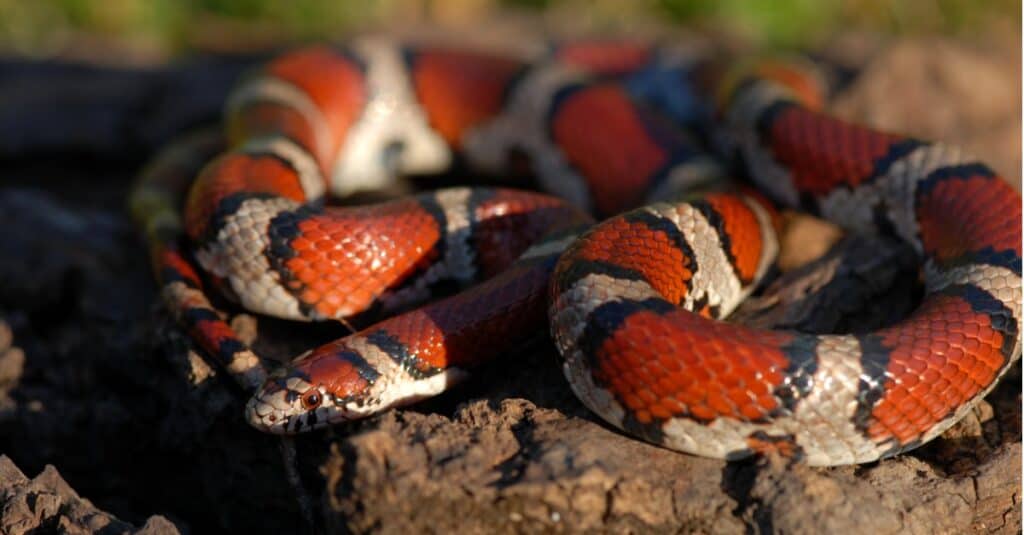
The common name “milk snake” originated from the false belief that these snakes milked cows.
©iStock.com/Shoemcfly
| Milk Snake | |
|---|---|
| Range | Western & Southeastern South Dakota |
| Length | 18-36 inches |
Contrary to popular belief, there are no coral snakes in South Dakota. What may look like a dangerous coral snake here is, in fact, nothing but a harmless milk snake. Milk snakes mimic the colors and patterns of venomous coral snakes so that predators will leave them alone.
Milk snakes are common in the southeastern counties of South Dakota and west of the Missouri River. However, these snakes are shy and secretive creatures, so they are rarely seen.
Milk snakes are red with white or light gray bands bordered in black running along the length of their smooth-scaled bodies. There are two subspecies of milk snakes in South Dakota; the pale milk snake and the red milk snake. Red milk snakes typically grow 24-36 inches in length, while pale milk snakes can be a bit smaller, growing 18-30 inches in length.
Western Hognose Snake
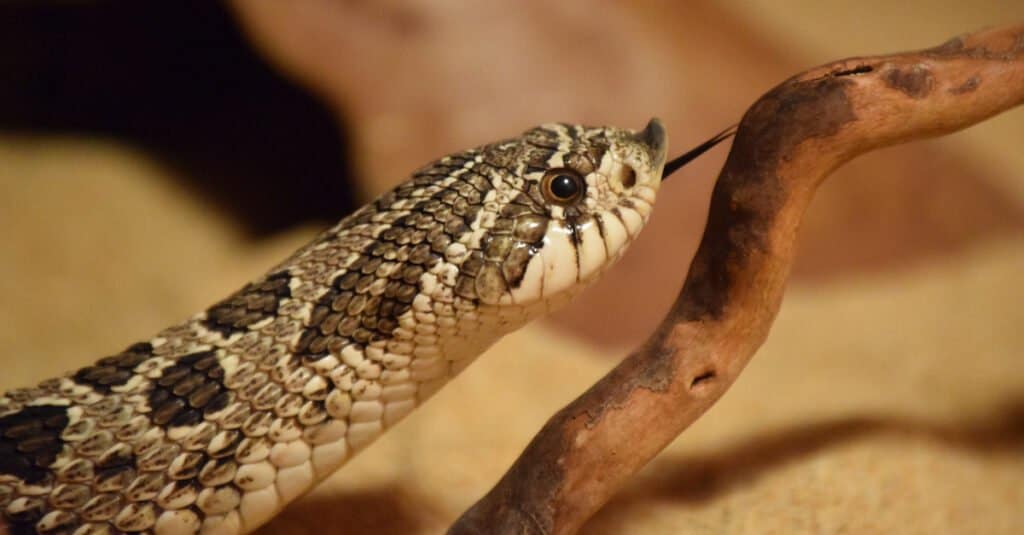
An upturned scale on the nose tip of the western hognose helps them dig through sand.
©Bryn Thomas/Shutterstock.com
| Western Hognose Snake | |
|---|---|
| Range | Scattered throughout all of South Dakota |
| Length | 15-26 inches |
The western hognose snake lives in various areas throughout South Dakota, but it is much more common in the western half of the state. This snake is often mistaken for a rattlesnake because of its similar coloring and patterns and because it mimics rattlesnake behaviors to keep away predators.
Western hognose snakes, however, do not have rattles and are easily identified by their upturned, horn-like snouts. These snakes are cream or tan in color, with two rows of dark blotches running along their backs and several dark spots along their sides.
Bullsnake

Bullsnakes are found throughout most of South Dakota, except in the northeastern regions.
©GoodFocused/Shutterstock.com
| Bullsnake | |
|---|---|
| Range | Western South Dakota; Southeastern edge of South Dakota |
| Length | 36-72 inches |
Bullsnakes are very common in the western half of South Dakota, as well as along the southeastern edge of the state. Although they live in a wide range of habitats, these snakes are commonly spotted near ranches, farms, and agricultural areas.
Bullsnakes are the largest species of snake in South Dakota. They can grow 36-72 inches in length, although, in South Dakota, they are typically between 36-48 inches at most. These snakes are light yellow or tan, with dark speckles or flecks. Dark blotches of red, red-brown, brown, or black run along their backs, with smaller blotches on their sides.
Plains Garter Snake
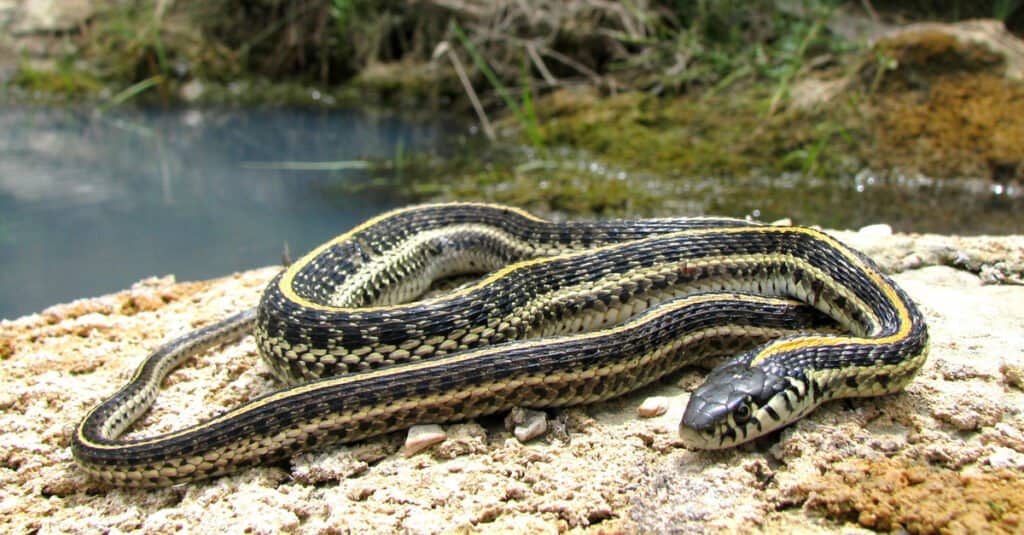
Garter snakes eat a wide variety of prey, like frogs, earthworms, insects, and small mammals.
©Joe Farah/Shutterstock.com
| Plains Garter Snake | |
|---|---|
| Range | All of South Dakota |
| Length | 20-28 inches |
Plains garter snakes are 20-28 inches long, with dark bodies that are usually brown, black, or olive green. Thin orange or yellow stripes run along the length of their bodies—one stripe along their back and one on each side. There are also two rows of black spots running along their sides as well. The plains garter snake is often more gentile and docile than many other types of garter snakes.
Common Garter Snake
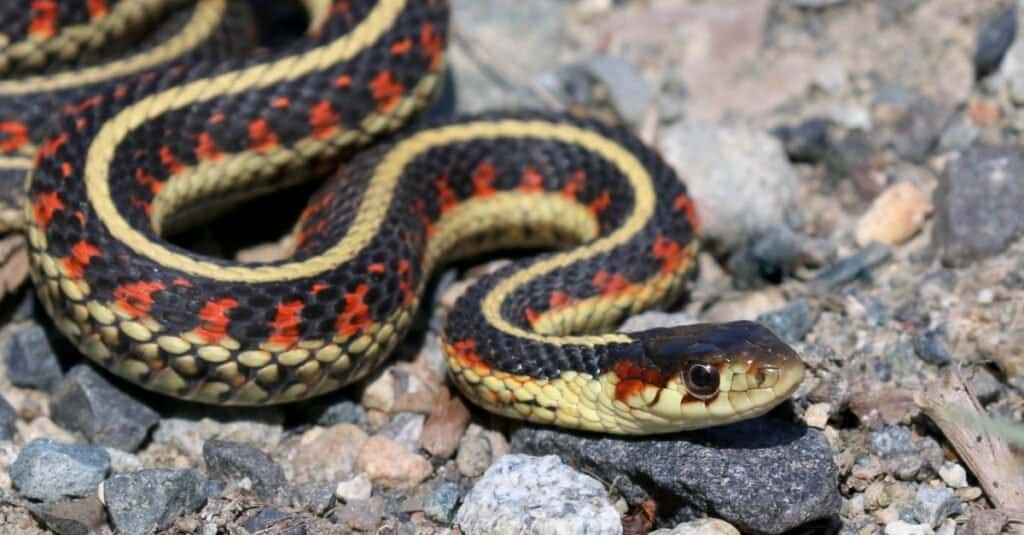
Garter snakes have large heads with small eyes.
©iStock.com/randimal
| Common Garter Snake | |
|---|---|
| Range | All of South Dakota |
| Length | 25-48 inches |
The common garter snake lives all throughout South Dakota. However, it is more frequently spotted in the western regions of the state. This snake is black, with thin yellow or orange stripes on its back and sides, running along the entire length of its body. There is also a checkered pattern with small red and black splotches between the yellow or orange stripes.
Common garter snakes typically measure 25-48 inches in length with a very long tail. Although they are not significantly dangerous, bites from common garter snakes can cause itching and burn due to their mildly toxic saliva. They are among the few animals that are immune to the toxic rough-skinned newt.
Eastern Yellow-Bellied Racer Snake
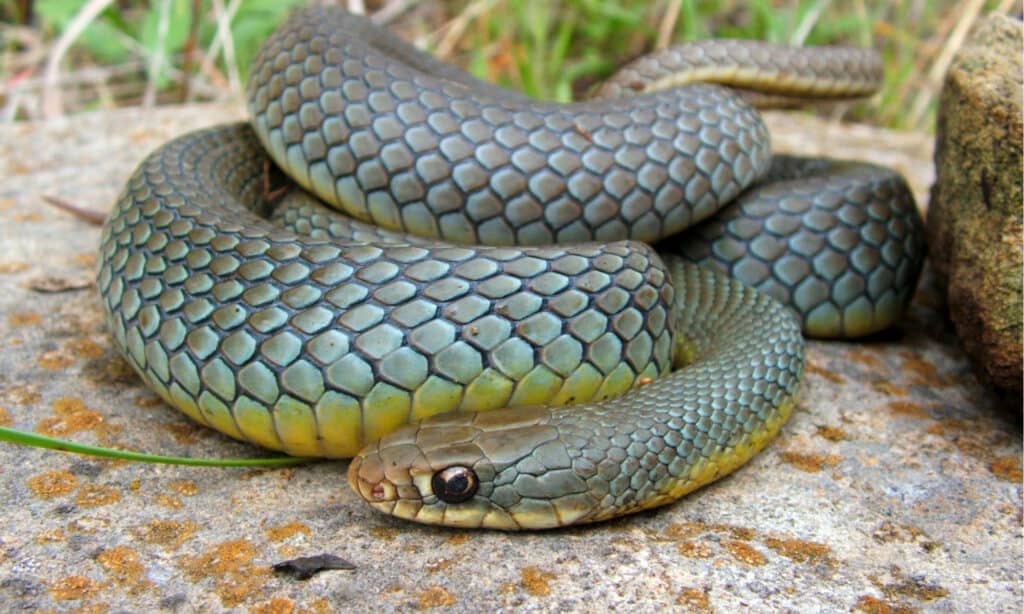
The eastern yellow-bellied racers are not venomous, but they are quick to bite.
©Matt Jeppson/Shutterstock.com
| Eastern Yellow-Bellied Racer Snake | |
|---|---|
| Range | Western South Dakota |
| Length | 30-50 inches |
Eastern yellow-bellied racers live in western South Dakota, typically favoring prairies, pastures, and grasslands areas. These are beautiful snakes with blue-green bodies, yellow bellies, and dark round eyes. Yellow-bellied snakes are a subspecies of the eastern racer and grow between 30-50 inches long. In South Dakota, they are often referred to as “blue racers” (not to be confused with a separate blue racer snake, Coluber constrictor foxii). Like their name, eastern yellow-bellied racers are quite fast. Their primary defense is to slither away from threats. However, they are nervous snakes and are prone to biting.
The photo featured at the top of this post is © Max Allen/Shutterstock.com
Discover the "Monster" Snake 5X Bigger than an Anaconda
Every day A-Z Animals sends out some of the most incredible facts in the world from our free newsletter. Want to discover the 10 most beautiful snakes in the world, a "snake island" where you're never more than 3 feet from danger, or a "monster" snake 5X larger than an anaconda? Then sign up right now and you'll start receiving our daily newsletter absolutely free.
Thank you for reading! Have some feedback for us? Contact the AZ Animals editorial team.






